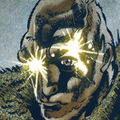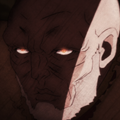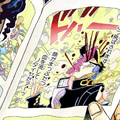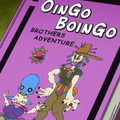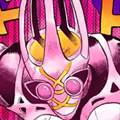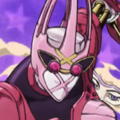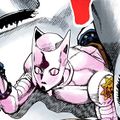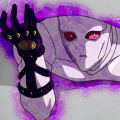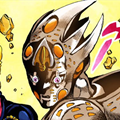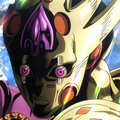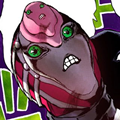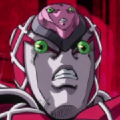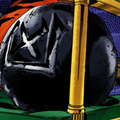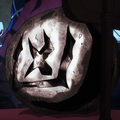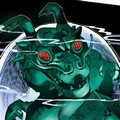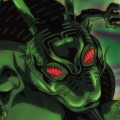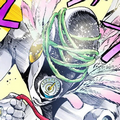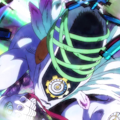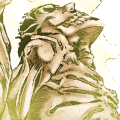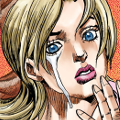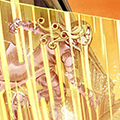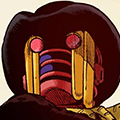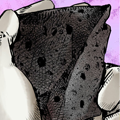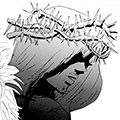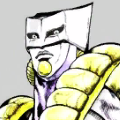Fate
Fate (運命, Unmei) is the concept of a predetermined course of events, especially one that serves a greater purpose. In the JoJo's Bizarre Adventure series, fate is taken as a fact, and greatly influences the story as a whole.
The conflict between human will and fate serves as a major theme throughout the series, most prominently in Phantom Blood, Diamond is Unbreakable, Vento Aureo, and Stone Ocean.
Summary

Fate is introduced as early as the first chapter of the series as an overarching force behind all things, and its influence is cited throughout the story. The exact nature and will of fate is never defined; nevertheless, by the end of Stone Ocean, it is understood to be a force that ultimately favors justice, even if it appears otherwise at points.[1] The Joestar bloodline is deeply tied to fate, with each generation destined to confront forces of evil, beginning with Jonathan Joestar's sacrifice against Dio Brando.[2][3]
Fate's existence is tangibly demonstrated several times throughout the series. Rolling Stones is directly stated to draw its energy directly from the power of fate, and Made in Heaven's ultimate purpose relies upon fate's existence and immobility. Cinderella is also said to use its power to affect fate directly. Other Stands such as Tohth and King Crimson, as well as certain talented individuals such as Tonpetty, are able to predict events that will occur in the near future with certainty, but with the caveat that said events cannot be altered in any way, only misunderstood. Even in King Crimson's case, events can only be removed entirely by erasing the period of time in which they occur. However, these and other powers that "reshape fate" are also accounted for by fate in advance, and as such only further play into its goals.[4]
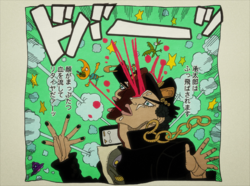
Though fate's grander shape generally remains unknown, certain patterns are identified within the story. The foremost example of these patterns is the idea of "gravity" between certain people that are fated to meet each other.[5] According to Toshikazu Hazamada, such a force acts on all Stand users, guiding them to meet each other either as friends or foes.[6] Enrico Pucci devotes himself to this idea, using it to justify various phenomena that aid him in his goals.[7] Ultimately, though the literal force of gravity is what allows Pucci to complete his Stand ability,[8] Emporio Alnino cites that very same gravity when explaining the priest's defeat.[1]
People can also exploit patterns in fate to infer its resolutions. Examples of this range from prophecies, such as the Red Stone of Aja being necessary to defeat the Pillar Men,[9] to fortune-telling performed by Wang Chan, Muhammad Avdol, and others. For example, Wang Chan predicts that Dio won't be caught by the police in the Joestar Mansion because he was born with impenetrable luck, based on the attributes of his face and the three moles on his ear.[10] Individuals such as Yoshikage Kira and Diavolo may also develop the idea that they have been favored by fate, though such beliefs are not guaranteed to be accurate.
Related Phenomena
Feng Shui
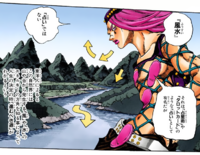
Feng Shui (風水, Fūsui, lit. Wind and Water), also called
Kenzou survived his cult's mass suicide by unknowingly standing in a lucky area, which was protected from the debris of the collapsing building he was inside. After being sent to prison, Kenzou harnessed the power of feng shui to perform assassinations, taking advantage of the lucky and unlucky areas of the human body to target their weak points while protecting himself from attack.[11] Kenzou's technique eventually manifested as Dragon's Dream, whose form includes both an arrow pointing to unlucky directions and a compass pointing to lucky directions; these allow Kenzou to determine the best course of attack at a glance, but also provide the same information to his opponents.[12]
Happiness
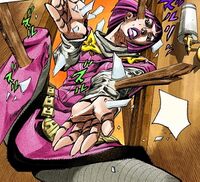
Happiness (幸福, Kōfuku) is a concept in Steel Ball Run that serves as the basis of the Saint's Corpse's power. Within the world, there is a balance of fortune and misfortune such that the two level out overall. The Saint's Corpse, when fully assembled, is able to manipulate that fortune by repelling misfortune from itself and its owner, leaving only good fortune and a state of "happiness" around both.[13] The only known exception to this principle is the law of gravity; as such, it can be overcome by gravity such as that created by two of the same person from parallel worlds existing in the same world,[14] or bypassed entirely by beings of infinite energy like Ball Breaker and Tusk ACT4.[15][16]
Upon awakening the corpse's power, Funny Valentine also gains the ability D4C Love Train, which creates a seam of light that Valentine can traverse and manipulate freely. However, Love Train is as much an evolution of his own Stand as it is an ability bestowed by the corpse; as such, the successor to the corpse's power (namely Parallel World Diego) does not gain a similar ability.[17]
Flow
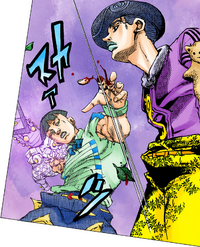
Flow (流れ, Nagare) is a concept in JoJolion proposed by Norisuke Higashikata IV. Norisuke believes that there is a "flow" or natural path for everything in life, even a simple fruit parlor, and that determining and accepting it is sure to lead one to their goal. This idea is later expanded by a natural law called Calamity (厄災, Yakusai), which functions as the basis behind Wonder of U, Toru's Stand.[18]
Calamity is an unavoidable negative energy that causes unfortunate events to occur as part of flows. In its natural state, it affects people at random, regardless of morality or circumstance, and regardless of whether they've made any mistakes or accepted the flows of things.[19] The law of calamity can manifest grievous misfortunes via any means necessary. For instance, calamity causes rain drops to pierce Josuke Higashikata, giving him near-lethal wounds,[20] and a falling leaf to slice off Joshu Higashikata's fingers.[21] Calamity can also manifest as an unfortunate chain of events: according to Mitsuba Higashikata, Yasuho Hirose's discovery of the New Locacaca fruit and Norisuke subsequently being incapacitated is also a part of the ongoing calamity targeting her and her family.[22]
To those who can see Stands, calamity is accompanied by a vision of Toru's Stand, Wonder of U, even after Toru's demise. The only known forces capable of averting an occurrence of calamity are those that transcend the flow of logic itself, such as the Spin as applied by Soft & Wet: Go Beyond.[23]
Mechanisms
Mechanisms (
Related Abilities
Creation and Development
Although he does not believe in God, Hirohiko Araki himself harbors a belief in some kind of overarching force, including the concept of fate. By extension, Araki believes that tackling subjects such as fate in his works, through proxies such as bloodlines, is what gives them meaning;[25] Araki thinks similarly of other works as well, praising works from The Book to Spider-Man for addressing the presence of destiny.[26][27] Nonetheless, he considers such factors to be an inevitability in the realm of manga, being determined by the circumstances of the work.[28]
However, Araki also believes that being unable to escape one's fate is more terrifying than death itself.[29] As such, he greatly admires and aims to write characters who move forward without consideration for fate, indirectly confronting and surpassing it in the process.[30][31] To Araki, the ability to move forward and carve out one's own fate is the greatness of humanity that he aims to celebrate in his manga.[32][33]
References
- ↑ Jump up to: 1.0 1.1 Stone Ocean Chapter 158: What a Wonderful World
- ↑ Chapter 116: Jotaro Kujo, Part 3
- ↑ Chapter 117: The Man with the Star Birthmark
- ↑ Stone Ocean Chapter 157: Made in Heaven, Part 9
- ↑ Chapter 17: The Birth of DIO
- ↑ Chapter 294: Yukako Yamagishi Falls in Love, Part 1
- ↑ Stone Ocean Chapter 136: Heavy Weather, Part 12
- ↑ Stone Ocean Chapter 148: C-MOON, Part 8
- ↑ Chapter 76: Ripple Teacher Lisa Lisa, Part 6
- ↑ Chapter 11: The Stone Mask, Part 4
- ↑ Jump up to: 11.0 11.1 Stone Ocean Chapter 67: Enter the Dragon's Dream, Part 1
- ↑ Stone Ocean Chapter 68: Enter the Dragon's Dream, Part 2
- ↑ Steel Ball Run Chapter 88: Break My Heart, Break Your Heart, Part 1
- ↑ Steel Ball Run Chapter 95: The World of Stars and Stripes - Outro
- ↑ Steel Ball Run Chapter 83: Ball Breaker, Part 1
- ↑ Steel Ball Run Chapter 86: Ball Breaker, Part 4
- ↑ Steel Ball Run Chapter 78: D4C, Part 11 -Love Train-
- ↑ JoJolion Chapter 99: The Wonder of You, Part 16
- ↑ JoJolion Chapter 98: The Wonder of You, Part 15
- ↑ JoJolion Chapter 90: The Wonder of You, Part 7
- ↑ JoJolion Chapter 104: The Wonder of You, Part 21
- ↑ JoJolion Chapter 95: The Wonder of You, Part 12
- ↑ JoJolion Chapter 108: Go Beyond, Part 2 Tailpiece
- ↑ The JOJOLands Chapter 1: Departure
- ↑ THRILL (September 2001)
- ↑ Araki x Otsuichi - The Book (December 2007)
- ↑ Playboy (July 2004)
- ↑ Monsoon Vol. 2 (March 1999)
- ↑ Quick Japan (December 2007)
- ↑ Vento Aureo Paperback Vol. 10 (August 2005)
- ↑ XxxHolic Guidebook (November 2006)
- ↑ Da Vinci (August 2005)
- ↑ Anime News Network (June 2017)
